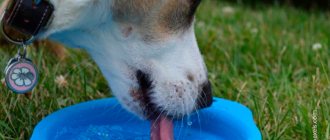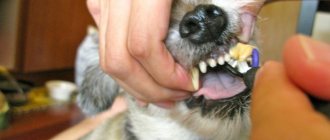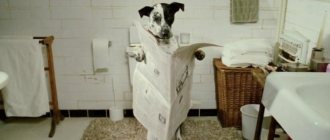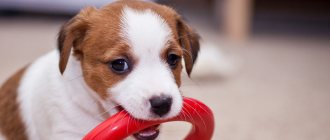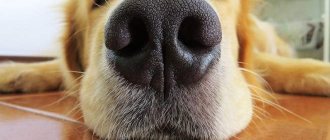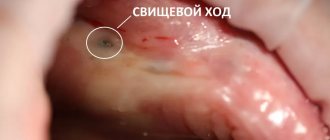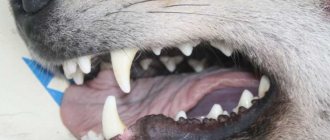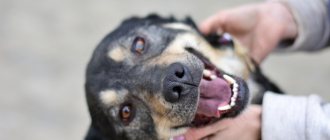During the first year of life, the dog's teeth are completely replaced from milk teeth to permanent ones. Usually by 7 months all teeth have been completely replaced. But it also happens that the permanent teeth are already growing, but the milk teeth do not have time to fall out; it turns out that two rows of teeth form in the dog’s mouth. Why this is possible and what to do about it, we will try to figure it out in this article.
In small breeds, development is often spasmodic and uneven. Situations often arise when molars grow too early, when milk teeth have not yet fallen out. They grow close to each other, creating a double-tooth effect, which is especially noticeable in the canine area.
A dog with double teeth is uncomfortable; their bite may form incorrectly.
What you need to know about your pet's teeth
Dogs' teeth begin to change at about four months of age. It is also worth saying that this process lasts up to about seven months.
The process of changing teeth has the following sequence:
- initial loss of incisors occurs;
- premolars and molars are replaced;
- there is a change of fangs.
As for the main difficulties in this process, most of them can be observed when changing the animal’s teeth, such as incisors and canines. This is due to the appearance of such a pathology as the second row of teeth in a dog. If you notice this phenomenon, you should immediately seek advice from a highly qualified veterinarian, who will direct all his actions to eliminate this phenomenon as effectively as possible, without harming the animal’s remaining teeth.
It is also worth saying that during a period such as the change of baby teeth, it is very important to maintain the recommended diet for the dog. This is necessary to ensure that your pet’s bite is formed as correctly as possible. It is also worth making sure that the dog receives the necessary diet filled with vitamins and minerals. It is especially important to consume enough calcium during this period, which will also have the best effect on the process of proper replacement of baby teeth.
Foods such as beef bones contain large amounts of calcium, but you should be careful not to chew or swallow them.
Changing teeth very often affects the general condition of the dog. During this period, the animal may be characterized by apathy, lethargy, and also loses its appetite. This is due to the fact that this process is in most cases accompanied by soreness of the gums and teeth. However, it is still possible to alleviate this condition, you just need to consult with a veterinarian who will tell you what actions should be taken and what medications you need to give your pet to relieve pain.
When do baby teeth appear?
Chihuahua puppies are born toothless. Milk teeth begin to erupt 2 weeks after birth. Sequence of cutting:
- First, a pair of central incisors emerge in the lower row, then in the upper.
- The lateral incisors are cut next.
- Behind them the fangs change (in any order).
- The premolars are cut last.
The growth of a Chihuahua's milk teeth lasts 2-3 months. Their development ends by 4 months of age.
What should be the correct grin on a dog?
The formation of the grin takes place during the first year of the pet’s life. By the end of this period, the animal's mouth should contain at least forty-two healthy teeth.
If you notice any deviations in this number and the dog’s extra teeth are noticed, this may indicate some disruptions in the development of the animal or mutations at the gene level.
As for the color indicator, the majority of milk fangs are distinguished by a bright white color, and after a period of change, they become slightly yellowish in color. This is considered normal, since the enamel should change as the animal grows.
If you pay attention to the characteristics of an animal’s bite, then it is worth saying that this indicator is different for individual dog breeds.
If the bite is correct, then age-related tooth wear occurs evenly and is practically unnoticeable; however, with an incorrect bite, this process can be one-sided, which is already an indicator of pathology.
Scheme of changing temporary teeth to permanent ones
At the age of 4 months, the formation of the rudiments of molars begins under the necks of milk teeth. Under the influence of chewing loads, baby teeth become loose and begin to fall out. The change occurs according to the following scheme:
- The incisors are the first to be replaced.
- Then ─ premolars. Simultaneously with their replacement, the eruption of molars occurs.
- The last ones to fall out are the fangs.
Normally, the change of teeth in puppies ends at seven months. Baby teeth that have not fallen out by the age of 9 months are subject to forced removal.
Teeth in two rows - a reason to seek advice from a veterinarian
If your pet has reached the age of one year, and you begin to notice the fact that his teeth are beginning to grow in two separate rows, then this is the most direct reason to seek advice from a veterinarian to determine the cause of this pathological condition.
Another interesting fact is that the doctor will examine the mouth under general anesthesia. Therefore, the dentist will first recommend a consultation with an anesthesiologist.
In order to understand as correctly as possible the causes of such a condition as a dog’s teeth in two rows, it is worth highlighting the most common causes of its occurrence:
- Initially, it is worth monitoring the appearance of the second row of teeth, as this may be due to the fact that the permanent canines have already appeared, and the milk ones have not yet fallen out.
- Certain processes of impaired growth of permanent canines or the complete absence of their rudiments.
- Complete preservation of baby teeth and appearance of permanent teeth. To eliminate this problem, it is worth removing the entire milk row.
- An animal's genetic predisposition or certain delays in its development.
Dental formula of Chihuahua dogs
Forming the correct bite and maintaining the integrity of the teeth plays an important role in breeding work. According to canine standards, toy Chihuahua dogs must have a scissor bite. And the teeth forming dental arches (arcades) are distributed strictly according to the following scheme:
- 28 milk teeth in puppies (6P+2K+6P each on the upper and lower jaws);
- 42 constants in adult dogs (6P+2K+8P+4M in the top row and 6P+2K+8P+6M in the bottom row).
The letters in the formulas indicate the types of teeth:
P ─ incisors;
K ─ fangs;
P ─ premolars;
M ─ molars.
Normally, the upper and lower dental arcades of a puppy consist of an equal number of teeth (14 on each). Adult Chihuahuas have 20 teeth on the upper arch and 22 on the lower arch.
How to properly care for a dog's mouth
A complete change of grin should occur by the time the animal is one year old; after the process is completed, a certain plaque and characteristic tartar begin to be deposited on the jaw.
As for the color indicator, yellow color is not an indicator of any pathology, but stone deposits are the most direct reason for consulting a veterinarian and subsequent elimination of accumulations.
In order to avoid all this as much as possible, it is necessary to carry out all the necessary procedures aimed at eliminating unnecessary deposits and accumulations, as well as carry out all the necessary sanitation procedures. This process includes the following points:
- When a dog has exclusively dairy “chews,” there is no need to clean them regularly.
- The animal's diet must contain all the necessary vitamins and microelements, such as phosphorus and calcium.
- The puppy must learn to chew fairly hard objects and large pieces of food. This is due to the fact that during the chewing process the grin cleans itself and will remain healthy.
- In order to clean the mouth mechanically, it is worth including dog crackers and beef bones in the animal’s diet.
- Pet stores today offer a fairly large number of special toys that perfectly clean your animal’s mouth. Consequently, by purchasing such entertainment, you will forget about what pathological putrefactive deposits on the dog’s jaw are.
- Dry food should not be pre-soaked, but given in dry form.
To summarize all of the above, it is worth noting that if you notice that your pet’s teeth are growing in two rows, this is the most direct reason to seek advice from a veterinarian. However, you should definitely monitor the condition of your pet’s grin, this will help avoid big problems in the future in the form of stones and other pathological deposits.
But you should also pay attention to the age of the dog. If, for example, your pet has not yet reached one year of age, then pathology such as a double row of teeth may be a simple replacement process that does not require additional intervention.
Should you brush your Chihuahua's teeth and how often should you do it?
Dogs of this breed have very thin and narrow jaws. Because of this, dental problems arise. In the plaque that forms on them, pathogenic microbes intensively develop. Cleaning prevents infections from developing. Therefore, you need to brush your teeth at least twice a week.
It is recommended to accustom your dog to brushing during puppyhood. This is done like this:
- For 1-2 weeks, the puppy is fed by hand, while touching its face.
- At the next stage, his lips are parted and his teeth are touched. The procedure ends with rewarding the pet for obedience.
- When the puppy learns to bare his teeth, begin cleaning. It consists of wiping the gums with a damp cloth in the morning and evening.
Forecast of dystopia
The appearance of a dystopic tooth in a child is not such a serious problem (especially if there is only one). Before a person’s facial skeleton stops growing, the position of the main teeth can be normalized quite quickly. Therefore, it is recommended to begin treatment immediately after identifying the problem. In this case, all the teeth will most likely fall into place and in the future, in adulthood, will no longer cause concern.
If correction of dystopia in an adult is required, this almost always causes many difficulties. After 18-20 years, teeth are no longer so mobile, so correcting their position requires many preparatory interventions. It is much easier to remove a problematic tooth than to try to put it back in place.
Being cured in a timely manner, dystopia has virtually no negative impact on a person’s future life. Most often, the correct bite is maintained for a long time and does not require supervision by a doctor.
Consequences of dystopia
Although dental dystopia does not seem like a terrible disease, it can create many problems. This is why wisdom teeth that have grown incorrectly are most often removed. Among the most unpleasant consequences of the disease:
- disruption of the entire dentition, because due to one incorrect element, the rest move or cannot erupt correctly;
- injury to the tissues of the cheeks, tongue, lips, which can cause ulcers and even provoke the development of tumors;
- complication of oral hygiene, which leads to inflammation, caries, both on the dystopic and adjacent teeth;
- the appearance of gingival pockets where bacteria accumulate, leading to pericoronitis;
- impaired chewing function, which in turn reduces the quality of food and can lead to deterioration of the gastrointestinal tract;
- difficulty pronouncing words, poor diction;
- violation of the facial skeleton, unaesthetic appearance of the lower part of the face.
Almost always, dystopia leads to unpleasant aesthetic consequences, which causes complexes and rejection of one’s appearance in the child, and then in the adult. Of course, this can be worked out with a psychologist, but it is much wiser and more correct to deal with the cause than to deal with the consequences.
Types of wisdom teeth dystopia
Wisdom tooth dystopia is classified depending on which direction the crown is shifted. The following types of disease are distinguished:
- vestibular (forward displacement);
- oral (teeth located behind the entire row);
- mesial (forward bend);
- distal (backward tilt);
- with supraposition (above the dentition);
- with infraposition (below the dentition);
- with tortoposition (the tooth is rotated around its axis);
- with transposition (the tooth is in the place of another tooth).
In the most severe cases, you can observe the appearance of a tooth outside the oral cavity: for example, inside the nose. This is very dangerous and requires immediate treatment.
How does socket healing occur?
The tissues are restored within approximately 10-15 days. At least by this point, the pain will go away, and external changes will no longer cause you concern. Of course, this is a conditional framework - the healing process for each patient occurs individually. Not only the injured gum is restored, but also the bone tissue inside the hole from which the root was extracted. Below we list approximate deadlines for all stages. If your symptoms are shorter/longer, there is no need to panic - you need to evaluate the remaining symptoms: when there are no additional manifestations of pathology, it means that rehabilitation is going according to plan.
- first 3 hours: after tooth extraction, bleeding occurs - this is a common situation, since the tissues have been injured. The hole is completely filled with blood, which normally immediately coagulates - this is how a blood clot or blood clot is formed. It is extremely important for normal rehabilitation! In fact, it is a natural barrier against the penetration of bacteria into the wound. The color of the hole is dark red,
- the first 2-3 days: the dark blood clot persists and thickens, its size decreases. Granulation tissue begins to form inside the hole - young connective tissue, which will become the basis for the restoration of the mucous membrane,
- 3-7 days: the clot brightens and acquires a whitish color. Granulation tissue covers almost the entire socket. Swelling and pain should decrease or even go away completely,
- 7-10 days: the blood clot dissolves, the remains can be seen only in the center of the hole, which has decreased in size. New bone tissue begins to form under the healing gum, which in 4-6 months will fill the defect from the edges to the center,
- after 15 days: young pink mucous membrane covers the entire socket, superficial healing is complete.
Symptoms of dystopia
Symptoms of dental dystopia are most often visual and easily noticeable. It is enough to look at the position of all the elements of the dentition to see that some of them are in the wrong places or are simply growing unevenly. Other symptoms:
- there is no tooth in the bite, and the period of eruption has already passed;
- inflammation and pain are felt at the site of the wisdom tooth;
- The wisdom tooth did not appear on time
It is interesting that in a number of cases there is no wisdom tooth at all - it does not form and does not erupt. Dentists call this option a variation of the norm.
How to treat inflammation of the periosteum of a tooth before visiting a doctor?
Self-medication for any purulent processes is very dangerous, so it is recommended to consult a dentist at the first symptoms of the disease. However, before visiting a doctor, the patient can alleviate his condition somewhat by applying cold to the cheek on the affected side and rinsing his mouth with an antiseptic solution at room temperature (chlorhexidine soda-saline solution, chamomile or sage decoctions). Here's what you absolutely can't do:
- Apply warm compresses and drink hot drinks.
- Apply any bandages yourself or use medications without a doctor’s prescription.
- It is better not to take analgesics before visiting the dentist.
- If you are undergoing surgery (opening an abscess), you should not take aspirin, since it changes the rheological properties of the blood and can cause bleeding.
Why can the periosteum of a tooth become inflamed?
The most common is odontogenic periostitis of the jaws, that is, an inflammatory process provoked by diseases of the teeth or periodontal tissues. Deep caries, pulpitis, periodontitis (inflammatory process at the apex of the tooth root), periodontitis - all these diseases, if not treated in time, lead to the appearance of gumboil. Also, one of the reasons for the development of the inflammatory process may be alveolitis - inflammation of the tooth socket, which in some cases occurs after tooth extraction. Inflammation of the periosteum after tooth extraction usually develops in those patients who do not rush to see a dentist when the first signs of complications appear in the postoperative period.
Much less common is toxic periostitis, caused by infection through the blood or lymph (usually due to some general infectious disease). The disease can also be caused by injuries to the jaw bone or surrounding soft tissue.
Removal of dystopic wisdom tooth
Removing a dystopic wisdom tooth is a fairly serious operation that requires professionalism and care from the doctor. Incorrect actions can lead to dislocation of adjacent teeth, lower jaw, injury to the mandibular canal and other problems. Therefore, it is very important to contact experienced specialists who are familiar with the specifics of removing complex teeth.
Indications for removing a dystopic tooth
Clear indications for removal:
- detection of a jaw cyst;
- traumatic dystopia;
- diseases of the jaw caused by this tooth;
- difficulties in treating caries in adjacent teeth;
- the appearance of pulpitis and periodontitis.
The practice is that the decision to remove a child is made taking into account all these factors. In an adult, it is more likely to decide whether to keep a tooth or not – removal is considered a universal solution, the simplest and safest. They resort to it in almost all cases.
Stages of removing a dystopic wisdom tooth
The removal operation is carried out in several stages. Compliance with technology allows you to protect the patient and simplify the operation for the doctor. Also, before starting work, detailed studies must be carried out: a full x-ray of the jaw is taken, all available caries is cured, etc.
During tooth extraction, the surgeon performs the following actions:
- Introduction of anesthetic. This may be local anesthesia or general anesthesia if several teeth are to be removed at once.
- Complete exposure of the tooth. To do this, a flap of mucous membrane and periosteum are peeled off.
- I sawed off the walls using a drill. This is necessary to align the element and make it easier to remove.
- Tooth extraction. The entire molar is removed using forceps. If the tooth was previously destroyed, its fragments are removed. It is important that the doctor removes all the fragments, otherwise inflammation will occur.
- Application of antiseptics to prevent the development of wound infection.
- Returning the mucosal flap to its place.
- Applying seams.
Once the wound is stitched, the operation is over, but the treatment is not. After a week, you should definitely see a doctor to have the stitches removed. It is also advisable to be observed by a specialist for 1-2 months to make sure that the removal had no consequences.
Removal of a dystopic tooth in pictures
Possible complications and diagnosis
If the disease is not treated properly, very serious complications soon develop: osteomyelitis (purulent inflammation of bone tissue, provoking its necrosis), phlegmon (a diffuse purulent process that affects nearby tissues and requires immediate surgical intervention), sepsis (a general infection of the body, often ending in the death of the patient ). Each of these conditions requires emergency medical care and long, painstaking treatment. Therefore, it is better not to let the situation lead to complications and contact a dentist at the first signs of an inflammatory process.
To establish an accurate diagnosis, the doctor will need to conduct a differential diagnosis using instrumental diagnostic methods (radiography, CT). This disease is similar in symptoms to acute periodontitis, acute inflammation of the salivary glands, lymphadenitis, and osteomyelitis. Therefore, in order to prescribe adequate treatment, it will be necessary to exclude these conditions and accurately determine the cause of the patient’s poor health.
How to help a puppy during teething changes?
Most puppies tolerate tooth changes quite easily. They do not require any special help. The main thing to do is to secure the house and provide the puppy with an opportunity to chew.
It is important to hide everything that should not get into the puppy’s mouth: wires, cables, shoes, sponges, small objects. This is necessary not only because valuables may be damaged, but also because it can be dangerous for the puppy. Your pet may receive an electric shock or accidentally swallow a foreign object.
Buy your puppy rubber rings, balls, use a Kong and treats. Let the puppy chew on what is safe. We recommend various natural SUPERPET delicacies made from venison. They are soft enough to not cause discomfort, but still satisfy your puppy's chewing instinct. Treats made from dried meat can be given chilled, this will also help cope with discomfort in the gums.
If the puppy bites your hands
If your puppy bites your arms or legs, do not scold him. Puppies do not understand that they bite hard and thus hurt. You can teach your puppy not to bite. When he bites you, let him know about it. For example, say “It hurts!” If your puppy stops biting you, praise him and give him a treat. If it doesn't work, calmly walk away from the puppy.
Once your puppy understands that his bites are causing you discomfort, offer him an alternative. Show that you can bite, for example, a rubber toy. Always keep toys handy to distract your puppy.
The teething period is an excellent opportunity to teach your puppy that human hands and feet are not designed for biting. If your pet bites your hand while playing, offer him a toy. If he continues to bite you, stop playing. Sometimes a puppy bites not because his gums hurt, but in a fit of excitement. By stopping the play, you show the puppy that his behavior is not desirable.
How to ensure that there are no complications after tooth extraction?
At the first stage, you need to choose a doctor who will carry out professional and careful removal without severe tissue injury. It is important that the operation is performed not by a dental therapist, but by a dental surgeon or even a maxillofacial surgeon - an implantologist. It is a highly specialized doctor who knows how important it is to preserve the volume of bone tissue so that after this operation there are as few restrictions as possible for implantation.
The most important thing after the operation itself is to strictly adhere to the instructions and recommendations given by the doctor. If medications are prescribed, they must be taken for a strictly prescribed time. See our short checklist of what you can and cannot do after surgery, as well as detailed recommendations that will help you shorten the rehabilitation period and go through it without pain and complications.
When can you eat and drink after surgery?
You should not strictly limit yourself in nutrition, you will need strength to recover - you can eat as soon as the anesthesia wears off, namely after 2-3 hours. You can drink it immediately after you remove the cotton swab. Until this point, it is undesirable for food particles or bacteria to get into the open hole.
In the first 3-5 days, you need to take into account several nuances in nutrition so that further healing of the wound goes well:
- food should be warm. Hot or cold food will irritate tissues and cause blood vessels to dilate or constrict, which can cause new bleeding,
- It is better to exclude rough food to avoid mechanical damage to the wound. Soups, purees, baked and boiled foods, minced meat dishes,
- Do not chew food on the side where the tooth was removed to keep the protective clot intact.
Carefully! Many people mistakenly believe that in the first days it is better to drink and eat liquid foods through a straw. But in fact, suction creates a vacuum in the mouth, which can displace the clot or disrupt its integrity. Should not be doing that. For the same reason, you should not spit or suck in your cheeks.
A short checklist: a list of recommendations after tooth extraction
What can and should be done
- hold the cotton swab applied by the doctor for 20-30 minutes,
- within 2-3 hours after surgery, be sure to apply cold compresses to reduce tissue swelling,
- carry out oral baths (not to be confused with rinsing) with antiseptic drugs for 3-5 days: “Miramistin”, “Chlorhexidine 0.5%” or other drugs prescribed by a doctor can be used as medicinal solutions,
- after 3-5 days, start using a toothbrush - only a soft one for the operated area, as well as a new one, without bacteria on it. The teeth of the opposite jaw can be brushed immediately, the main thing is to avoid the area of the extracted tooth,
- chew food on the side opposite the injured area,
- You can drink water immediately, preferably warm water,
- You can eat only after the anesthesia wears off, that is, after 2-3 hours,
- Lead a quiet lifestyle, try to avoid physical activity and heavy lifting for 5-7 days.
What you should absolutely not do
- don't rinse your mouth! Mouth baths in the first 3-5 days are more than enough,
- do not use hot compresses! This is fraught with the appearance of edema and the development of inflammation,
- do not create a vacuum in your mouth: do not puff out your cheeks, sneeze, blow your nose and spit very carefully,
- do not pick the wound, do not touch the clot with your tongue,
- do not drink or eat hot or cold food, only warm food,
- try to quit smoking for at least 2-3 days after surgery,
- Do not drink alcohol for 2-3 days - it does not promote tissue repair. Also exclude it if the doctor has prescribed a course of antibiotics,
- Do not overcool or overheat - give up sports exercises, swimming pools, saunas for 5-7 days.
What is distal bite (occlusion)
This is a pathology in which the upper jaw is not located at the same level as the lower jaw, but is significantly pushed forward, as a result of which the teeth close incorrectly, with displacement. And not only the front ones, but also the lateral ones, which creates a block that prevents the healthy development of all incisors.
It arises and develops as a result of one, several or a whole group of interrelated factors (discussed in detail below), which entails other anomalies, most often diastema. Over time, it also causes weakening of the chewing muscles, respiratory problems and other complications that are dangerous to the body.
Conclusions. Expert advice
Dystopia is the incorrect position of a tooth in the jaw: its displacement forward or backward, down or up, as well as rotation around its axis or tilt. The appearance of such an anomaly is associated both with hereditary factors and with bad habits or mechanical damage to the jaw. The sooner dystopia is detected, the easier it is to cure. In adults, the wisdom tooth most often found to be dystopic is the third molar, because there may simply not be enough space in the jaw for it to erupt.
The consequences of such anomalies include general malocclusion, frequent inflammatory diseases, impaired chewing function, and much more. Depending on the complexity of the case, dystopia is treated either by tooth extraction or with the help of braces. If the decision is made to remove it, it is important to carry out the operation carefully and correctly. If treatment is started on time, the prognosis for the disease is positive.
Prevention of dystopia
Dentists are confident that if you carefully monitor your child’s dental health from early childhood, you can avoid most bite problems. Dystopic teeth are no exception, because their appearance is not always associated with hereditary factors. To prevent dystopia, doctors recommend the following:
- proper nutrition, adherence to the daily routine of a pregnant mother;
- prevention of jaw injuries from an early age;
- regular visits to the dentist, wearing devices to correct malocclusion;
- giving up bad habits (including weaning off the pacifier after a year and from thumb sucking in sleep), etc.
If you and your child regularly visit a dentist, he will give recommendations on what exactly to do in your case.
How to brush your Chihuahua's teeth at home
Before you start cleaning, you need to let the puppy sniff the brush and let it lick the paste. It is better to brush a puppy’s teeth with a small, soft rubber brush; for an adult dog, with a toothbrush with nylon bristles. Procedure:
- Spread your pet's lips;
- Apply a brush with toothpaste to your teeth;
- Make circular or scraping (top to bottom) movements with it;
- Rinse off the paste with a stream of water (if required);
- After cleaning, massage your gums with a massager brush.
